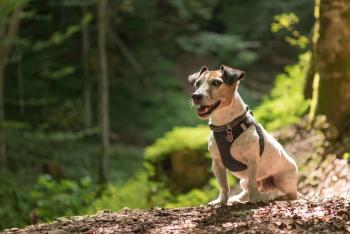
Simply golden: A Golden Retriever Lifetime Study veterinary visit
Take a peek inside a veterinary visit as Truman the golden retriever visits his veterinarian to provide samples for the study, funded by Morris Animal Foundation.
What's a veterinary visit like for a participant in the Golden Retriever Lifetime Study (GRLS)? Golden retriever Truman, hero No. 2,874, and his owner, Andrea Cole, share their experience here.
Cole, pictured with Truman. All images by Portia Stewart
“The hardest part for us is tracking everything, because in the yearly report you have to track what their food is, did you give them any other supplementary food like meat or vegetables,” Cole says. “We try to switch up Truman's food so it's not the same thing. So the challenge is tracking all the labels, which I have down to a science now.”
Truman holds still for a blood draw.
Collecting samples is a key element of the study, and during the annual visit hair, nail, urine, fecal and blood samples are all collected. Truman is famous at his veterinary practice for being a gentleman and holding very still for his blood draws. For the study, 56 ml of blood is collected.
The veterinary team works to collect a sample of Truman's blood. “I can't tell if he likes it or not, cause he gets lots of treats afterward, but it's a lot of blood,” Cole says. “And I think I'm probably more used to it now that he's almost 4. But when you take your 6-month-old puppy in and they start taking vials of blood it's kind of weird. I'm like, is he going to have any blood left? They're like, yeah, he's going to be fine. I'm like, I don't know if I give that much blood. And here's my little puppy, just pumping it out.”
Truman with credentialed veterinary technician Lisa Schelinski.
Truman wears a Whistle collar that tracks his activity level and GPS location.
Technician Lisa Schelinski holds Truman as Valerie Partch, DVM, performs a nail trim to collect a nail sample.
A veterinary sample collection box is sent to study participants about 10 days after they complete their annual questionnaire. Cole's husband drops it off a week before their visit so Dr. Valerie Partch can review the contents and prepare for Truman's visit.
Cole gifted Jackson Animal Clinic with this plaque to recognize their role in the study.
The GRLS forges bonds that last a lifetime. Dr. Partch worked at a veterinary practice in Lee's Summit, Missouri, when she diagnosed Cole's golden retriever Raleigh with cancer. When Cole adopted her next golden, Truman, and enrolled him in the study, Dr. Partch was excited to help out. And when Dr. Partch moved across the metro area, to Jackson Animal Clinic in Platte City, Missouri, Cole and Truman followed. Cole says it's worth the drive to stay connected with her veterinarian-turned-friend and to keep Truman's health care continuous with his veterinarian.
From right to left: Valerie Partch, DVM; Andrea Cole, holding Truman; and veterinary technician Lisa Schelinski.
“The dogs in the study probably get a little bit more attention, and we look at their statistics a bit more than the average dog,” Cole says. “But unfortunately Truman's not going to get the benefit of this study. So it's pretty cool to see that people are so committed to keep it going.”
Dr. Partch examines Truman.
Before she completes the extensive annual veterinary questionnaire, Dr. Partch prints it out so she can review it as she conducts her exam. “Most of the stuff is information we already have saved on him, general health questions, his age, his weight, previous conditions. And the physical exam is a standard physical exam you do on every dog anyway.”
Newsletter
From exam room tips to practice management insights, get trusted veterinary news delivered straight to your inbox—subscribe to dvm360.





